Half-Life Feature Preview
GameSpot takes a closer look at the Dreamcast version of Sierra's incredible first-person shooter and gets the scoop on the game's exclusive new add-on adventure, Blue Shift.
Ever since Sierra first announced it would bring its popular first-person shooter to the Dreamcast, the list of possible enhancements to and features of the game has been in a state of constant flux. Fortunately, we were able to speak with the game's producer to get the skinny on the enhanced graphics, the multiplayer mode, the rumored Internet play, and the exclusive new single-player adventure, Blue Shift.

The Dreamcast version of Half-Life will contain the original Half-Life adventure exactly as it was presented on the PC, plus an entirely new single-player adventure, Half-Life: Blue Shift. Both games will be available for play at the start of the game, and neither game will offer a multiplayer mode. Randy Pitchford, the game's producer, comments: "Half-Life for the PC has heavily focused on the single-player experience. That's what's earned Half-Life more than 50 game of the year awards on the PC, and it's what we wanted to give the most attention to." The single-player game in both the original Half-Life adventure and the new Blue Shift episode should be enough to satisfy most fans, but with the Dreamcast versions of both Quake III Arena and Unreal Tournament supporting online play, Half-Life's solely single-player experience may leave some Dreamcast owners wanting more. Sierra's answer is two entirely separate Half-Life games - this one without online play, and a new multiplayer-focused title sometime in the future. According to Pitchford, the second Half-Life game will focus entirely on the multiplayer experience and might even contain ports of the PC expansion packs. "We've talked about including Half-Life deathmatch, Team Fortress Classic, Half-Life: Opposing Force deathmatch, and capture the flag, and we may even include one or more of the popular Half-Life mods [to the multiplayer game]," Pitchford said. "If it turns out to be viable, we'd likely also add the entire single-player game of Half-Life: Opposing Force as a bonus."
Half-Life tells the story of the Black Mesa complex - a massive secret government lab built into a plateau in the middle of the desert. In the original Half-Life adventure, you play as Gordon Freeman, a midlevel scientist who's involved in a strange classified experiment that goes awry. This horrible accident causes major damage to the facility and kills several of the staff, but it also appears to open some sort of gate to another dimension, and hordes of terrible alien beings have sprung from the portal and are killing everything in sight. As you progress through the game, the plot becomes more involved, and you learn there's more to the experiments and the Black Mesa complex than you originally thought.
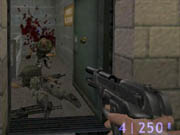
In the new Blue Shift adventure, you play as Barney the security guard, a regular security guard at the Black Mesa complex who also witnesses the accident and must deal with the alien threat in his own ways. Blue Shift involves more than simply switching skins on the characters - Barney has his own adventure that, while existing in the same time and place as Gordon's, has different objectives and story mechanics. Barney's narrative parallels Gordon's, and in some places the plots of the two adventures cross paths. This, according to Pitchford, allowed the team to create some fun scenarios where the two heroes cooperate. "I think the coolest thing about Blue Shift is that we've been able to toy with the player's experience," Pitchford said. "People who have played Half-Life know certain things about what's taking place and what characters and enemies to expect to encounter. When Blue Shift starts, Barney the character doesn't know any of that. The player, however, knows what Gordon was doing at any given time and will get a kick out of the times when we show Barney what Gordon or any of the other characters are up to."
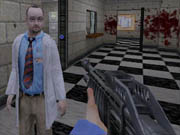
Barney will have different means of achieving his goals than Gordon. In the original Half-Life adventure, the focus was on shooting lots of aliens and occasionally dealing with machines and objects. Barney the security guard will definitely see some shooting action, but his primary objective is not to deal with the alien threat directly, but to rescue any of the scientists and civilians trapped in the Black Mesa facility. In the second half of the adventure, Barney will be working very closely with some of the most important scientists in the facility to help formulate an escape plan. As such, he will spend plenty of time operating the facility's machinery and dealing with the game's NPCs. "In Blue Shift, you'll be doing many neat new things in order to accomplish your objectives," Pitchford revealed. "Much of the challenge of the game revolves around interacting with other characters, combat, dealing with environmental problems, and reacting to surprise encounters. The fun is in the uniqueness and novelty of each individual moment that takes place in the game. From the time early in the game where Barney witnesses the accident that triggers all of the chaos at the facility to the time when he must rescue the scientist responsible for everything, there's a lot of contextually appropriate action that is not only intense in and of itself, but is also designed to properly advance the plot. Although much of it is familiar because it takes place in the Black Mesa facility, all of it is totally new." Unfortunately, you won't be able to control a group of armed soldiers or even security guards. "In some respects, Barney in Blue Shift has a lot more complex interactions with NPCs than Shephard did in Opposing Force," Pitchford continued. "But, unlike Shephard, Barney does not have the authority to be ordering heavily armed soldiers around."
Still, Barney has some new tricks up his sleeve. "There is a great deal of new content throughout Blue Shift," Pitchford said. "Besides the miles of new environments to explore and the new Berretta 9mm handgun Barney is equipped with, there are a lot of unique things to interact with. Barney will operate and manipulate some pretty cool equipment in the game, but I don't want to spoil it for anyone who hasn't played it yet. I think what's going to get the most impact, however, are the new and upgraded characters, monsters, and weapons. The new M-4 assault rifle and Spas 12 shotgun seem to get a lot of positive reactions from players, not only from their look, but also from their new sound effects." The Blue Shift adventure will feature a total of 27 levels and will have its own unique ending that ties in with the ending of the original Half-Life scenario. Because of the limited space available on the Dreamcast's GD-ROM, Blue Shift will be a tiny bit smaller than the other Half-Life add-on packs. "[Blue Shift] was designed to be long enough to be engaging and feel complete, but short enough to fit with the original game on the Dreamcast and to encourage everyone to experience the whole thing from beginning to end," Pitchford said.

The Dreamcast version of Half-Life will not be just a flash in the pan PC to DC port. "With Half-Life for the Dreamcast, we've heavily invested in not doing just a cheap port, but enhancing the title to look better than it's ever looked before," Pitchford said. Both scenarios have received major graphical face-lifts in the Dreamcast version. "All of the characters and weapons in the game have been re-created with twice the amount of polygonal detail, added articulation for more highly detailed animation, and new textures that offer much improved mapping quality," Pitchford continued. As a result, Half Life looks considerably better on the Dreamcast than it ever did on the PC. The animations are smoother, the effects look better, and the characters themselves are much more realistic looking. Sierra wanted to take a different route than most ports - adding to its game instead of taking elements away during the conversion. "So far, everyone else who's brought a popular PC game to the Dreamcast has just done a quick and dirty port," Pitchford said. "Oftentimes, material has to be cut or replaced with simpler content (as in Quake III Arena on the Dreamcast) to get it done more quickly or fit within the console's parameters. Most of the time the games are fun and are well received by Dreamcast owners who don't have the opportunity to experience the game on the PC. But, so far, no one's really invested the time and energy to take things a step further on the platform. The most important thing to remember with Half-Life for the Dreamcast is that Valve, Sierra, and Gearbox really decided to invest a lot in doing the title right."
As part of this investment, Sierra sought the help of Captivation Digital Laboratories early in the development cycle to ensure that the game ran better on the Dreamcast with the new enhancements than it ever did on the PC. According to Pitchford, CDL was a huge help in the development process: "Captivation is a group of developers who know the Dreamcast inside and out, and they've really taken on the tough job of making the technology perform great on the Dreamcast, while we've focused on the overall quality of the title and the new and enhanced content that is helping to make Half-Life for the Dreamcast the best shooter on the platform. But, as far as the difficult technical work goes, this is Captivation's title."
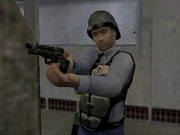
While Sierra has taken the time to ensure that every element of Half-Life is brought to the Dreamcast exactly as, if not better than, it was on the PC, there is still one huge issue that proves to be a major stumbling block with every PC to DC port - the controller. Sierra is addressing the issue in a unique way. "Any given player has a favorite interface that depends a lot on his or her past experience with similar games," Pitchford said. "For players who experienced Half-Life on the PC, many of them would find it difficult to move over to a console controller. Luckily, the Dreamcast features a keyboard and mouse, which is great. But, since we don't feel it's fair to expect every Dreamcast owner to invest in the PC-style interface, we've put a lot of effort into making the game fun with a controller. The Dreamcast controller actually feels very nice in the hands and has some neat features that make it very suitable for controlling a game like Half-Life. For example, the controller offers two finger triggers that feel a lot like an actual trigger - these can be used to fire weapons in a very natural way. We've also adjusted the game code in places to make the game easier to play with the controller." Additionally, Sierra plans to allow picky gamers to set any configuration they choose. "We've included a number of preset configuration options that we felt are most suitable for the way the Dreamcast joystick is designed," Pitchford continued. "But we've also made sure to include custom configurability so players can define for themselves a unique interface with the controller, the keyboard, the mouse, or any combination of the three and save that custom configuration to their VMU."
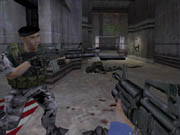
Sierra is hard at work bringing both chapters of the Half-Life saga to the Dreamcast. And, despite the lack of a multiplayer or Internet mode, Half-Life is definitely a Dreamcast game to keep an eye on. With an awesome storyline, excellent gameplay mechanics, and a solid reputation, Half-Life will no doubt be one of Sega's biggest releases this year. And though Sierra has stood firm on its original plan to release two separate Half-Life games, given SegaNet's huge current marketing campaign and Half-Life's unexplained release delays, an online mode just might show up in this version of Half-Life.
Q&A With Randy Pitchford, producer of Half-Life for the Dreamcast.
GameSpot: Besides the extra scenario, what will be the main differences between the Dreamcast and PC versions of Half-Life?
Randy Pitchford: Half-Life for the Dreamcast is hugely upgraded. All of the characters and weapons in the game have been re-created with twice the amount of polygonal detail, added articulation for more highly detailed animation, and new textures that offer much improved mapping quality. The result is that Half-Life for the Dreamcast looks better than ever. And, the upgraded content is applied not only to the original game of Half-Life, but it's also used with the included all-new episode called Half-Life: Blue Shift.
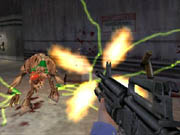
GameSpot: How do you feel the Dreamcast controller compares with mouse control? And do you feel it'll be easier to adapt the game to the DC controller than other console controllers? How will you handle it?
Randy Pitchford: Any given player has a favorite interface that depends a lot on his or her past experience with similar games. For players who experienced Half-Life on the PC, many of them would find it difficult to move over to a console controller. Luckily, the Dreamcast features a keyboard and mouse, which is great. But, since we don't feel it's fair to expect every Dreamcast owner to invest in the PC-style interface, we've put a lot of effort into making the game fun with a controller. The Dreamcast controller actually feels very nice in the hands and has some neat features that make it very suitable for controlling a game like Half-Life. For example, the controller offers two finger triggers that feel a lot like an actual trigger - these can be used to fire weapons in a very natural way. We've also adjusted the game code in places to make the game easier to play with the controller.
In any case, we've included a number of preset configuration options that we felt are most suitable for the way the Dreamcast joystick is designed. But we've also made sure to include custom configurability so players can define for themselves a unique interface with the controller, the keyboard, the mouse, or any combination of the three and save that custom configuration to their VMU.

GameSpot: What is the premise behind the new scenario?
Randy Pitchford: In Half-Life: Blue Shift, players take on the role of the Black Mesa security guard known as Barney. Black Mesa is the research facility where all the mayhem of Half-Life takes place. In Blue Shift, players are actually progressing through Barney's narrative as it happens during the exact same time of the events of the original game. This allows for the plots of the two games to cross over in some very interesting ways. Barney's motivations and objectives are unique, however, as he and his coworkers struggle to survive an alien invasion and escape from a military double cross. I think the coolest thing about Blue Shift is that we've been able to toy with the player's experience. People who have played Half-Life know certain things about what's taking place and what characters and enemies to expect to encounter. When Blue Shift starts, Barney the character doesn't know any of that. The player, however, knows what Gordon (the hero of Half-Life) was doing at any given time and will get a kick out of the times when we show Barney what Gordon (or other characters) are up to. You have to experience it first-hand to get the full impact, but I think my description gives you an idea of what I'm talking about.
GameSpot: How long will the new scenario be? As long as Opposing Force? Longer?
Randy Pitchford: Like Opposing Force, Blue Shift is an entirely new episode with all of the necessary plot elements for a complete narrative. It spans about 27 levels, which makes it a little bit shorter than Opposing Force. It was designed to be long enough to be engaging and feel complete, but short enough to fit with the original game on the Dreamcast and to encourage everyone to experience the whole thing from beginning to end.
GameSpot: One of our favorite moments in OF was being able to lead a small team of soldiers. Will that be possible in the new scenario?
Randy Pitchford: In Half-Life: Opposing Force, the player took on the role of Adrian Shephard, who was ranked a corporal. When most of the soldiers evacuated late in the Half-Life plot, Shephard found himself with the highest rank among the small groups of grunts who were left behind. So, he could order them around in order to accomplish his goals. In Blue Shift, the player takes on the role of Barney the security guard. During the second half of the game, he works very closely with some of the most important scientists in the facility to help formulate an escape plan. Barney will also be responsible for rescuing the civilian scientists from the soldiers who have been ordered to eliminate them.
So, in some respects, Barney in Blue Shift has a lot more complex interactions with NPCs than Shephard did in Opposing Force. But, unlike Shephard, Barney does not have the authority to be ordering heavily armed soldiers around - in fact, most of the soldiers Barney meets will be trying to silence him!
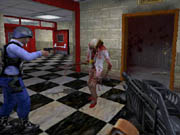
GameSpot: What tasks will this character perform that are unique to his scenario?
Randy Pitchford: Without ruining the surprise of the experience as it unfolds, I'll mention that in Blue Shift you'll be doing many neat new things in order to accomplish your objectives. Much of the challenge of the game revolves around interacting with other characters, combat, dealing with environmental problems, and reacting to surprise encounters. The fun is in the uniqueness and novelty of each moment that takes place in the game. From the time early in the game where Barney witnesses the accident that triggers all of the chaos at the facility to the time when he must rescue the scientist responsible for everything, there's a lot of contextually appropriate action that is not only intense in and of itself, but is also designed to properly advance the plot. Although much of it is familiar because it takes place in the Black Mesa facility, all of it is totally new.
GameSpot: Is there any relation between this scenario and the Half-life Uplink scenario? I'd heard there might be.
Randy Pitchford: Half-Life: Blue Shift is entirely new and is connected to the previous Half-Life games only through the time and location that the game takes place and the characters the player encounters.
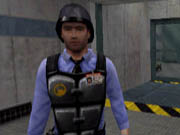
GameSpot: Will there be any new creatures, characters, weapons/devices, or environments? If so, what will they be?
Randy Pitchford: There is a great deal of new content throughout Blue Shift. Besides the miles of new environments to explore and the new Berretta 9mm handgun Barney is equipped with, there are a lot of unique things to interact with. Barney will operate and manipulate some pretty cool equipment in the game, but I don't want to spoil it for anyone who hasn't played it yet. I think what's going to get the most impact, however, are the new and upgraded characters, monsters, and weapons. The new M-4 assault rifle and Spas 12 shotgun seem to get a lot of positive reactions from players not only from their look, but also from their new sound effects (which make both weapons seem very impressive).
GameSpot: How will the multiplayer side of the game be handled? What are you looking at doing?
Randy Pitchford: Now that SegaNet has launched, we can talk a little bit about our hopes to create a second Half-Life title for the system that focuses on the multiplayer games. We've talked about including Half-Life deathmatch, Team Fortress Classic, Half-Life: Opposing Force deathmatch, and capture the flag, and we may even include one or more of the popular Half-Life mods. If it turns out to be viable, we'd likely also add the entire single-player game of Half-Life: Opposing Force as a bonus to be included with the multiplayer-focused title.
We'll be seriously investigating this once Half-Life for the Dreamcast goes gold and we can properly invest the time it requires. If Dreamcast players like Half-Life as we've presented it to them and if SegaNet takes off, we'd love to give them more Half-Life to play online and off.
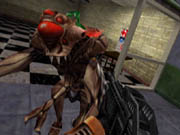
GameSpot: Is there anything that I haven't covered in my questions that you'd like to comment on?
Randy Pitchford: The most important thing to remember with Half-Life for the Dreamcast is that Valve, Sierra, and Gearbox really decided to invest a lot in doing the title right. So far, everyone else who's brought a popular (or not popular) PC game to the Dreamcast has just done a quick and dirty port. Oftentimes, material has to be cut or replaced with simpler content (as in Quake III Arena on the Dreamcast) to get it done more quickly or fit within the console's parameters. Most of the time, the games are fun and are well received by Dreamcast owners who don't have the opportunity to experience the game on the PC. But, so far, no one's really invested the time and energy to take things a step further on the platform.
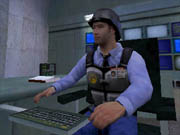
So, with Half-Life for the Dreamcast, we've heavily invested in not doing just a cheap port, but enhancing the title to look better than it's ever looked before. We've also invested a huge amount in creating a never before seen episode (Blue Shift) to make this title even more important to the Half-Life saga and for Dreamcast owners.
Additionally, Sega and Sierra helped get Captivation Digital Laboratories involved early in the process to make sure the game performs better on the Dreamcast with the upgrades than the game did on the PC's original required and recommended system requirements. Captivation is a group of developers who know the Dreamcast inside and out, and they've really taken on the tough job of making the technology perform great on the Dreamcast, while we've focused on the overall quality of the title and the new and enhanced content that is helping to make Half-Life for the Dreamcast the best shooter on the platform. But, as far as the difficult technical work goes, this is Captivation's title.
All in all, we're extremely pleased with how the game has developed, and we can't wait to release it to the Sega Dreamcast, where I hope it gives players as much fun and entertainment value as it did for the PC players.
Got a news tip or want to contact us directly? Email news@gamespot.com
Join the conversation